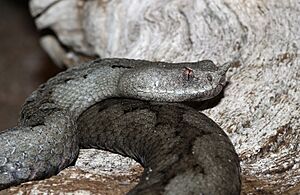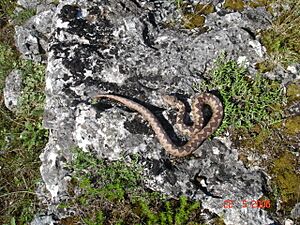Horned viper facts for kids
Quick facts for kids Horned viper |
|
|---|---|
 |
|
| Conservation status | |
| Scientific classification | |
| Synonyms | |
|
The horned viper (scientific name: Vipera ammodytes) is a type of viper snake. It is also known as the long-nosed viper or sand viper. You can find this snake in southern Europe, especially in northern Italy, the Balkans, and parts of Asia Minor.
Like all vipers, the horned viper is venomous. It is considered one of the most dangerous vipers in Europe. This is because of its large size, long fangs (up to 13 mm), and strong venom. The name ammodytes comes from Greek words meaning "sand" and "burrower". This is a bit funny because the snake actually prefers rocky places, not sandy ones! There are five recognized types, or subspecies, of this snake.
Contents
What Does the Horned Viper Look Like?
The horned viper usually grows to about 85 centimeters (33 inches) long. However, most individuals are smaller, often less than 75 centimeters (30 inches). Snakes from northern areas tend to be larger than those from southern areas. For example, on Golem Grad island, females were about 35 cm (14 in) and males 37 cm (15 in). The largest snake found there was 66 cm (26 in) long.
Its Unique Horn
The most special feature of the horned viper is a soft, flexible "horn" on its snout. This horn is about 5 mm (0.2 inches) long. It is made of small scales. In some subspecies, the horn stands straight up. In others, it points diagonally forward.
Scales and Body Shape
The snake's head has small, bumpy scales. There are also larger scales above its eyes. Its body is covered with strong, ridged scales. These scales are usually in 21 to 23 rows around the middle of its body. Males and females have a different number of scales on their bellies and under their tails.
Color and Pattern
The color of horned vipers changes between males and females.
- Males often have dark brown, gray, or black marks on their heads. A thick black stripe runs from behind their eye to their jaw. Their tongue is usually black, and their eyes are golden or coppery. Males also have a dark blotch or V-shape on the back of their head. This mark often connects to the zigzag pattern on their back. Their body color can be gray, yellowish-gray, or yellowish-brown. The zigzag pattern on their back is dark gray or black.
- Females have similar patterns, but they are less clear. They usually do not have the dark V-shape on their head. Their body color is often brown or bronze, like reddish-brown or copper. The zigzag pattern on their back is a shade of brown.
Both male and female horned vipers have a zigzag stripe on their back. This stripe is usually darker than their body color. Their belly can be grayish, yellowish-brown, or pinkish. Sometimes, the belly is black or bluish-gray with white spots. The tip of their tail can be yellow, orange, red, or green. Young snakes look similar to adults.
Where Do Horned Vipers Live?
You can find horned vipers in many parts of Europe and Asia. This includes north-eastern Italy, Slovenia, Croatia, Bosnia-Herzegovina, Serbia, Montenegro, Albania, Kosovo, Macedonia, Greece, southern Austria, Romania, Bulgaria, Turkey, Georgia, and Syria.
What Kind of Places Do They Like?
The name "sand viper" can be a bit confusing. These snakes actually prefer dry, rocky hillsides with not too many plants. They usually don't live deep inside forests. If they are near woodlands, they stay at the edges or in clearings. You might also find them near people, like on railway banks, farms, or vineyards. They especially like places with piles of rocks or stone walls. They can live at high altitudes, sometimes above 2,000 meters (6,500 feet).
How Do Horned Vipers Behave?
Horned vipers don't have a specific time of day they prefer to be active. In higher, cooler places, they are more active during the day. In warmer, lower places, they might be active at any time. They become more active at night when daytime temperatures are very high.
Even though they are known for their venom, these snakes are usually calm. They are not aggressive and don't often bite unless they are really bothered. If surprised, they might stay still and hiss loudly. Some might hiss and then try to get away. Others might try to bite right away.
In winter, horned vipers go into hibernation. They sleep for about 2 to 6 months, depending on how cold it gets.
What Do Horned Vipers Eat?
Adult horned vipers mostly eat small mammals and birds. Young snakes mainly eat lizards. How they eat depends on the size of their prey. If the prey is large, they strike it, let it go, follow it, and then swallow it. If the prey is small, they swallow it right away without using their venom.
Sometimes, they eat other snakes. There have even been reports of them eating their own kind. They also eat arthropods, like large insects and centipedes. Young vipers often eat centipedes, such as the Mediterranean banded centipede.
Reproduction and Life Cycle
Before mating, male horned vipers perform a "combat dance." This is similar to what adders do. Mating happens in the spring, usually in April or May.
Horned vipers give birth to live young, meaning the babies hatch inside the mother. This is called being ovoviviparous. One to twenty baby snakes are born in late summer or fall, usually between August and October. When they are born, the young snakes are about 14 to 24 centimeters (5.5 to 9.5 inches) long.
Horned Viper Venom
The horned viper is probably the most dangerous snake in Europe. Its bite can be a serious medical concern in some areas.
The venom is very strong. It can cause a lot of damage to tissues and affect the nervous system. It also contains substances that can make blood clot or cause bleeding. If a person is bitten, they will quickly feel pain, swelling, and discoloration around the bite. They might also feel dizzy or have a tingling sensation. Luckily, bites are rarely deadly if the person gets medical help quickly.
Humans, mice, and birds react strongly to this venom. Lizards are less affected. Some amphibians might even survive a bite. Other European snakes, like Coronella and Natrix, seem to be immune to the venom.
The venom from Vipera ammodytes is actually used to make antivenin. Antivenin is a medicine that helps treat bites from other European vipers. Because of this, some horned vipers are raised specifically for their venom.
Horned Viper Subspecies
This species was first described by Carl Linnaeus in 1758. Later, George Albert Boulenger identified several subspecies that are still recognized today. Here are the main subspecies:
| Subspecies | Common name | Where it lives |
|---|---|---|
| V. a. ammodytes | Western sand viper | Austria, north Italy, Slovenia, Croatia, Bosnia-Herzegovina, Serbia, Montenegro, North Macedonia, Albania, Kosovo, south-west Romania, north-west Bulgaria |
| V. a. gregorwallneri | Austria, Slovenia, Croatia, Bosnia-Herzegovina, Serbia, Montenegro, North Macedonia | |
| V. a. meridionalis | Eastern sand viper | Greece (including Corfu and other islands), Turkish Thrace |
| V. a. montandoni | Transdanubian sand viper | Bulgaria, south Romania |
| V. a. transcaucasiana | Transcaucasian sand viper | Georgia, north Turkish Anatolia |
Conservation Status
The horned viper is a protected species. It is listed under Appendix II of the Berne Convention. This means it is strictly protected.
Horned Vipers in Captivity
These snakes are often kept in zoos or by snake enthusiasts. They usually do well in captivity, much better than some other European vipers. They adapt easily to their new homes and usually start eating without much trouble.
However, even though they are generally calm, it's important to be careful when handling them. They are quite strong and can unexpectedly move free from a person's grip. For close check-ups, it's safer to use a clear plastic tube to hold them gently.
Images for kids






